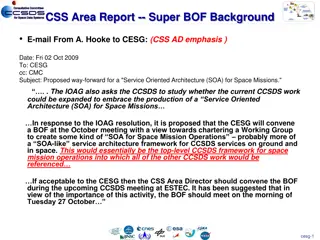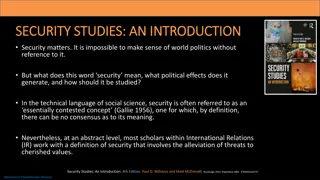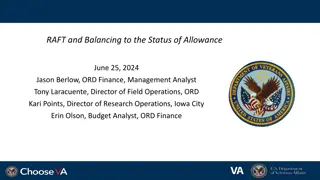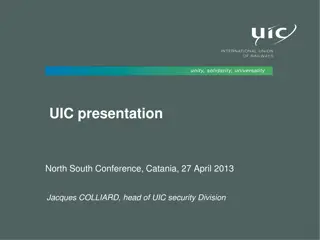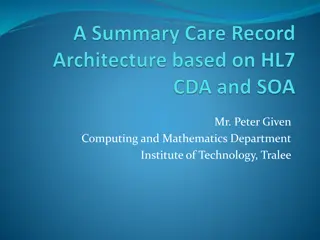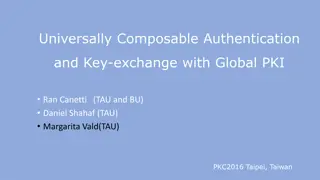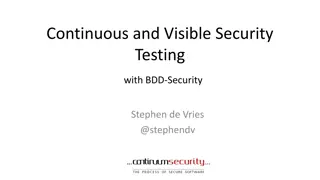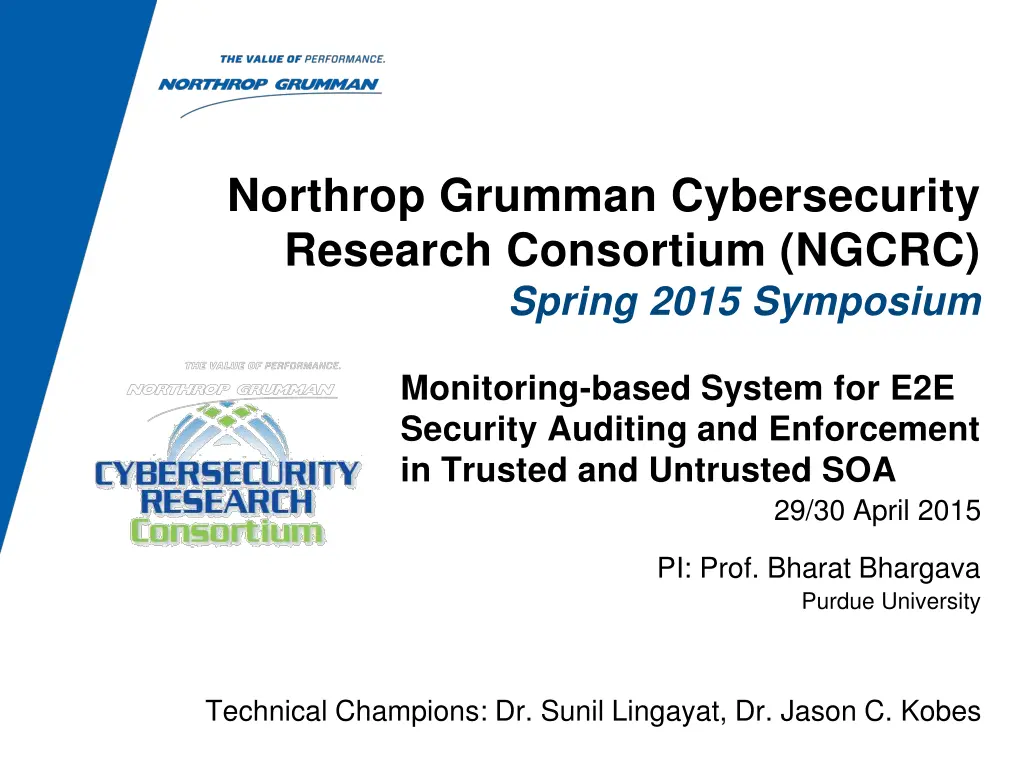
Innovative Security Solutions for Service-Oriented Architectures
Enhance security in service-oriented architectures through monitoring, auditing, and enforcement mechanisms. Address security challenges like unauthorized access, service misbehavior, and data privacy breaches. The proposed solution offers dynamic trust management, agile defense mechanisms, and proactive security measures for resilient service interactions.
Download Presentation

Please find below an Image/Link to download the presentation.
The content on the website is provided AS IS for your information and personal use only. It may not be sold, licensed, or shared on other websites without obtaining consent from the author. If you encounter any issues during the download, it is possible that the publisher has removed the file from their server.
You are allowed to download the files provided on this website for personal or commercial use, subject to the condition that they are used lawfully. All files are the property of their respective owners.
The content on the website is provided AS IS for your information and personal use only. It may not be sold, licensed, or shared on other websites without obtaining consent from the author.
E N D
Presentation Transcript
Northrop Grumman Cybersecurity Research Consortium (NGCRC) Spring 2015 Symposium Monitoring-based System for E2E Security Auditing and Enforcement in Trusted and Untrusted SOA 29/30 April 2015 PI: Prof. Bharat Bhargava Purdue University Technical Champions: Dr. Sunil Lingayat, Dr. Jason C. Kobes
Project Participants Prof. Bharat Bhargava Dr. Pelin Angin Rohit Ranchal, PhD student Denis Ulybyshev, PhD student Prof. Leszek Lilien Dr. Lotfi ben Othmane 2
Problem Statement Service B Service A Service C Service D Trust Domain SOA: Loosely coupled independent services are composed to accomplish tasks Involves interactions of trusted and untrusted services No client control on the chain of service invocations Problems: Attackers can gain control of a number of services, modify a service or get access to in-transit messages Client does not have ability to specify service interaction policies Violations, malicious activities and failures in a trusted service domain may remain undetected Services are not verified or validated dynamically (uninformed selection of services) Malicious activity may cause service disruptions 3
Problem Statement Service B Service A Service C Service D Trust Domain There is need for novel techniques to Monitor service activity Discover and report service misbehavior Ensure security and privacy of data in SOA and clouds. If a service is compromised or misbehaves, the service monitor should Discover malicious activity Provide feedback Take remedial actions Adapt according to changes in context. 4
Benefits We propose a novel method of dealing with security problems in SOA: Monitoring all interactions among services in a domain Provides increased awareness of security violations Proactive treatment of potentially malicious service invocations Leads to increased security Dynamic trust management of services in a domain Enables timely detection of potentially compromised services Agile and resilientdefense mechanisms Ability to adapt in the presence of anomalies Dynamic reconfiguration of service compositions Privacy preservation in service interactions Prevention of data leakage The monitoring-based security solution: Provides enforcement of security policies in addition to auditing capability Offers a proactive security solution by detecting anomalies across individual service interactions and at the domain level Ensures uninterrupted service even under attacks and failures Provides a transparent mechanism for service monitoring that can be used in standard web service frameworks 5
Technical Approach Overview Service Monitor Active Bundle request Instrumentation Passive Service 1 Passive Listener Passive Monitoring Algorithms Active Active Listener Interaction Authorization Algorithms request (if authorized) Active Bundle State Listener response request Heartbeat & Inflow Listener Policies Service 2 Dynamic Service Composition Anomaly Detection Trust reconfiguration Management Service monitor intercepts all client-service/service-service interactions. The approach aims to provide a unified security architecture for SOA and cloud by integrating components for: Service trust management Interaction authorization between different services Anomaly detection based on service behavior Dynamic service composition Secure data dissemination using active bundles 6
Solution Components Policies Passive Listener Active Listener Active Bundle Listener Heartbeat Module Authorize Log Trust React Analyze Management Agile Defense Detect Resiliency & Adaptability Agile Defense Anomaly Detection 7
Agile Defense Goals: Replace anomalous services with reliable versions Reconfigure service orchestrations in response to anomalous service behavior Swiftly adapt to changes in context Ensure continuous availability even under attacks and failures Components: Monitor service status and determine action Update service health status in case of significant deviations from normal behavior Create service backup in case of suspicion of anomaly Re-deploy service in case of complete failure Dynamic service reconfiguration based on changes in context Adapt priorities (e.g. response time vs. level of detail/accuracy) Adapt constraints (e.g. trust levels of all services > T for critical mission) Dynamically replace failed services in composition with healthy ones to avoid complete restart of business process Controlled sharing of data Determine data dissemination based on the requirements and authorization level of the subscriber Limit data disclosure based on trust level of subscriber Control dissemination based on changes in context (e.g. emergency, attack, etc.) 8
Distributed Service Monitoring for Cross-domain Anomaly Detection and Adaptability *: service request data *: summary service health data S4 * * S5 MB S6 S1 * * Domain B S7 * S2 * * * MC S9 MA * S3 Domain C Domain A * * S10 S11 * * * * * S12 MD ME Domain E Domain D Central Monitor Each monitor MX tracks all requests in its domain, gathering response time, heartbeat data, response status, authorization/authentication failures, and reports summary to central monitor. Distributed monitoring allows for collection, analysis and reaction to dynamic cyber events, preventing propagation of threats within or outside the domain of anomalous service. 9
Anomaly Detection Approach Statistical analysis of multivariate time-series data collected by service monitors to detect significant deviations from normal behavior Adjusts service threat levels based on duration, extent & type of anomalies Correlation of time-series data from multiple services allows for detection of bigger threats (affecting the whole domain, collaborative attacks etc.) Ability to detect zero-day attacks as opposed to signature-based models 60 140 # of authentication 120 50 CPU usage (%) 100 40 failures 80 S1 S1 30 S2 S2 60 S3 20 S3 40 10 20 0 0 time (-->) time (-->) Diagnosis: Anomaly affecting whole domain Response: Re-deploy all services in different domain /switch to backup versions in different domain Diagnosis: Anomaly affecting S1 Response: Replace S1 10
Hidden Markov Models (HMM) for Anomaly Detection HMM: Simplest dynamic Bayesian network model Consists of states X and an observation sequence (output tokens) Y, whose probability of occurrence depends on the state States hidden, but outputs of each state observed Sequence of observations related to each other Task: Given model s parameters and sequence of observations, compute distribution over the hidden states of the last variable in the sequence aij: State transition probabilities, bij: Output probabilities Xi: States (normal, attack, high load, failure etc.) yi: Observations ({low response time, high response time, normal response time}, {high CPU usage, no CPU usage, normal CPU usage} ) Train HMM with service operation data under normal conditions (to detect anomalies) Merge with measure of distance between different sets of time-series data to assess significance of deviation from normal 11
Dynamic Service Composition Reconfiguration An SOA service orchestration is composed of a series of services that interact with each other based on a service interaction graph One of the multiple services in each service category can be selected for specific service functionality, E.g. category: weather, services: weather.com, Yahoo weather, accuweather Challenge: Configuring set of services to comply with SLA and security policy requirements Dynamic service composition reconfiguration is based on Changes in context Type, duration, extent of attacks and failures 12
Dynamic Service Composition Approach This problem is an instance of the multiple-choice multiply-constrained knapsack problem (MMKP): tij: utility of service j in category i xij: indicator for participation in a service composition (of service j in category i) cijk: value of service j in category i for constraint category k Ck: threshold value for constraint category k Si: set of services in category i p: number of constraints m: number of service categories MMKP is NP-hard, therefore we use a greedy heuristic-based approach to find near-optimal solutions 13
Dynamic Service Composition Experiments Dynamic service composition overhead is especially important in time-critical settings Measure response time overhead of dynamic service composition for: (1)Different number of service categories in a composition (2)Different number of services to choose from for each category Setting: Central service monitor on Amazon EC2 m3.medium instance (1 vCPU, 3.75 GB memory) Composition time dominated by the database access time and not affected significantly by the number of possible services in a category or the number of service categories involved in the composition. Composition overhead reasonable for most settings. Composition involving 3 service categories, with varying number of services for each category Composition involving varying number of service categories, with 3 possible services for each category 800 800 Composition time Composition time 700 700 600 600 500 500 (ms) (ms) 400 400 300 300 200 200 100 100 0 0 3 5 10 20 3 5 10 20 number of service categories number of services per category 14
Data Privacy in SOA Data (D) = {d1,..,dn} D Point-to-Point authentication is unable to protect data dissemination in unknown domains TRUSTED DOMAIN Service 1 may not want to disclose its service composition to the user D D SERVICE 2 d2 SERVICE 1 d1 Secure channel but no policy communication, evaluation, enforcement Unauthorized data disclosure resulting in undetected user privacy violation Opaque data sharing by Service 1 to services in unknown domain D D SERVICE 4 d4 SERVICE 3 d3 UNKNOWN DOMAIN 15
Research Tasks Develop a policy-based distributed data dissemination framework to: Ensure each authorized subscriber service only accesses the data for which it is authorized Prohibit data dissemination to an unauthorized subscriber service Demonstrate compatibility of solution with existing service infrastructure (e.g. RESTful services) Demonstrate applications (such as Electronic Healthcare Records, UAVs) for controlled cross- domain information exchange under various anomalies and attacks 16
Proposed Solution Data item (di) = <ki, vi> Policies (P) = {p1,.., pm} Ciphertext (C) = {c1,.., cn} Function set (F) USER D, P, C, F P, C, F P, C, F SERVICE 2 K2 , P, C, F SERVICE 1 K1, P, C, F P, C, F P, C, F SERVICE 4 K4 , P, C, F SERVICE 3 K3, P, C, F if (host == authorized) F(ki, P, C) = di 17
Proposed Framework Practical implementation of function F, policy P, and ciphertext C Active Bundle approach for secure data dissemination Active Bundle (AB) Self-protecting data encapsulation mechanism Provides secure cross-domain information exchange Sensitive data (encrypted) Metadata Access control and operational policies Virtual Machine Protection mechanism (self-integrity check) Policy evaluation, enforcement and data dissemination 18
Framework Components Host authentication can be based on Password, Certificate, Biometric, PKI Host request authorization is based on policy evaluation Supports different access control models such as Attribute/Role-based Key management methods Key inclusion (prone to attacks) Key management service (use of trusted third party for key storage and distribution) Dynamic key derivation based on the unique information generated in AB execution control flow steps only if the service is authenticated and authorized Tamper Resistance Correct data dissemination depends on the correct execution of AB control flow steps Verifies the integrity of the execution steps to ensure there is no difference from the original code (using secure one-way hash function) Derives keys based on digests of AB execution steps and their resources Any modification of AB changes the digest resulting in incorrect key derivation 19
Cross-Domain Data Dissemination Multispectral imagery Location coordinates Infrared imagery Location coordinates UAV 1 UAV 2 UAV 3 Command & Control Time period Deployed personnel Target locations Intelligence reports Mission expenses Deployed weapons Casualties Press Release Top Secret Confidential Unclassified Secret 20
Cross-Domain Data Dissemination Multispectral imagery Location coordinates Infrared imagery Location coordinates UAV 1 UAV 2 UAV 3 Time period Deployed personnel Target locations Intelligence reports Mission expenses Deployed weapons Casualties Press Release Command & Control Time period Deployed personnel Target locations Intelligence reports Mission expenses Deployed weapons Casualties Press Release Top Secret Confidential Unclassified Secret Target locations Intelligence reports Mission expenses Deployed weapons Press Release Mission expenses Press Release Press Release 21
Attack Resilience Attacks on AB Man-in-the-middle: during AB transfer or interaction between AB and service Tamper attack on code or policies of AB Repudiation attack Trusting the AB and its execution Digital signatures to validate the authenticity and integrity of AB Containerized execution of AB (e.g. using Docker containers) Cloud-based execution Protecting AB against malicious receivers Tamper resistant code (code integrity checks) Correct secret key generation only in case of correct execution Cloud-based execution (third party code execution vs third party data broker) 22
Experimental Setup Measurements Experiment 1: Growth in AB size with increasing number of policies Experiment 2: Growth in AB and Service interaction time with increasing number of policies Experiment 3: Tamper Resistance overhead in AB execution Variations AB versions ABx XACML-based policies and WSO2 Balana-based policy evaluation ABxt ABx with tamper resistance capabilities ABc JSON-based policies and JAVA-based policy evaluation ABct ABc with tamper resistance capabilities Number of AB policies Environment Amazon EC2 C3 Large and XLarge instances Data collection 5 runs of each experiment repeated 100 requests per run 23
Experiment 1: AB Size vs Number of policies Observations Linear growth in AB size with increase in number of policies for all versions Tamper resistance adds a slight overhead to AB size (< 2 KB) 79% reduction in policy size (0.79 KB) with JSON-based policies Additional reduction of 8.5 KB with Java-based policy engine 24
Experiment 2: AB-Service Interaction Time vs Number of policies growth in interaction time with Observations Linear growth in interaction time with increase in policies for ABx and ABxt Use of XACML-based policies and external library (WSO2 Balana) for policy evaluation Evaluation of XACML policies involve the traversal of XML policy and request trees Constant growth in interaction time with increase in policies for ABc and ABct Use of JSON-based policies and Java code for policy evaluation Highly optimized Java code evaluation 25
Deliverables Prototype implementation of proposed monitoring framework: Local (domain-level) Service Monitor (implemented using Apache Axis2 valves for interception, MySQL database for logging) Central Monitor (implemented as Web service on Amazon EC2) Anomaly Detection Module Dynamic Service Composition Module (algorithm) (enables integration with business process composition using dynamic partner links in BPEL) Active Bundle Module AB implementation as an executable JAR file AB API implementation using Apache Thrift RPC framework Policy specification in XACML/JSON and evaluation using WSO2 Balana Documentation: Source code Deployment and user manual Report on performance and security testing of solution 26 NORTHROP GRUMMAN PRIVATE / PROPRIETARY LEVEL I
Demonstration Agile Defense Detection of failures and attacks Service composition reconfiguration based on context changes Data Privacy Policy-based selective data dissemination Context-based controlled data dissemination 27
Impact Comprehensive security auditing and enforcement architecture for SOA Continuous monitoring of SLA and policy compliance Swift detection of failures and attacks in the system Efficient mechanism to dynamically reconfigure service composition based on the system context/state (failed, attacked, compromised) and resiliency requirements Resilient architecture to ensure continuous service availability under failures and attacks Privacy-preserving data sharing approach for client-to-service and service-to-service interactions Compatibility of solution with industry standard SOA frameworks 28 NORTHROP GRUMMAN PRIVATE / PROPRIETARY LEVEL I
Future Work Refining anomaly detection process with best service health parameters (to improve runtime performance and maximize accuracy) Extend Active Bundle implementation to exchange state information with Service Monitor Protecting AB execution against control flow hijacks Experiments: DoS and DDoS attacks on services Tampering attacks on services (code injection etc.) Man in the middle attacks (using an intercepted active bundle) Attacks against data privacy (trying to bypass active bundle protection mechanism) Tampering attacks on active bundle s policies and code Service performance evaluation with/without monitoring (CPU and memory usage) Central service monitor scalability evaluation with stress tests Service failures (evaluation of speed of detection by service monitor) Performance evaluation of dynamic service composition algorithm for different service compositions (different number of service categories/services in composition) Cloud experiments: Framework scalability on industry standard cloud platforms (e.g. Amazon EC2) Integration with NGC projects: Cyber 2.0 IRAD (resiliency) (with Dr. Sunil Lingayat) Complex Organization and Decision Analytics (CO&DA) (with Dr. Jason C. Kobes) BluVector (machine-learning based anomaly detection in enterprises) 29
Presentations and Publications Policy-based Distributed Data Dissemination, R. Ranchal, D. Ulybyshev, P. Angin, and B. Bhargava. Consumer-Oriented Privacy-Preserving Access Control for Electronic Health Records in the Cloud, R. Fernando, R. Ranchal, L. Othmane, and B. Bhargava. An End-to-End Security Auditing Approach for Service Oriented Architecture, M. Azarmi, B. Bhargava, P. Angin, R. Ranchal, N. Ahmed, A. Sinclair, M. Linderman, and L. ben Othmane. Privacy-Preserving Identity Claims with Complex Service Provider Policies, R. Fernando, and B. Bhargava. SORT: A self- organizing trust model for peer-to-peer systems, A. Can, and B. Bhargava. A Trust-based Approach for Secure Data Dissemination in a Mobile Peer- to-Peer Network of AVs, B. Bhargava, P. Angin, R. Ranchal, R. Sivakumar, A. Sinclair, and M. Linderman. Protection of Identity Information in Cloud Computing without Trusted Third Party, R. Ranchal, B. Bhargava, L. ben Othmane, M. Linderman, M. Kang, A. Kim, and L. Lilien. 30 NORTHROP GRUMMAN PRIVATE / PROPRIETARY LEVEL I
Potential End-to-End Scenario using 3 NGCRC Projects (concept by Dr. Steiner, NGC) High security assurance in SOA Service Selection based on trust level of user (1) (2) Secure Browser User Authenticate to browser (trusted e.g. CAC or untrusted e.g. PIN) Request data processing User Machine Trusted Service Encrypted Data Processing Untrusted Service Data Processing (3) NGCRC Projects Univ. Data (potentially corrupted) Secure Hardware Tokens and Key Storage in the Browser End to End Security Policy Auditing and Enforcement in Service Oriented Architecture Ensuring Privacy in Cloud-based Data Analysis Encrypted Data MIT (1) Purdue (2) Untrusted Cloud Untrusted Cloud Purdue (3) Northrop Grumman Private / Proprietary Level 1
Dynamic Service Composition Algorithm //Input: A set of mservice categories Si, each with a set of concrete services. //Output: A set of services, one in each category, with near-optimal utility based on context. sort services in every category in descending order of utility for i: 1..m xi1 = 1 // select the highest utility service for the initial composition if return current composition //solution satisfies constraints else while solution not feasible //downgrade using the service with biggest aggregate saving in constraints for each category i for each service j in i calculate aggregate saving of service in category i of the current composition with j find service j with maximum aggregate saving find service with max aggregate saving across all categories, include in the composition return composition 34
Adaptability Cost and Benefit Consideration Benefits: Increased availability of services (measured by up-time and throughput) Increased performance by obviating the need to restart invocations of service compositions with failed/attacked services (measured by total response time) Increased security and flexibility in service composition based on priorities and constraints in a specific environment (measured by success of avoiding attacks) Costs: Dynamic service composition time cost Cost to maintain central service monitor Service response delay due to monitoring Increased resource usage in service domain Overhead of re-deploying service in same/different domain 35










